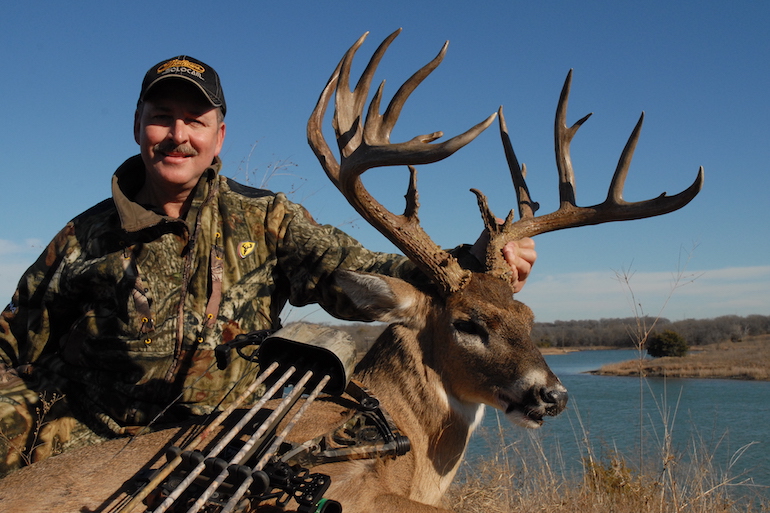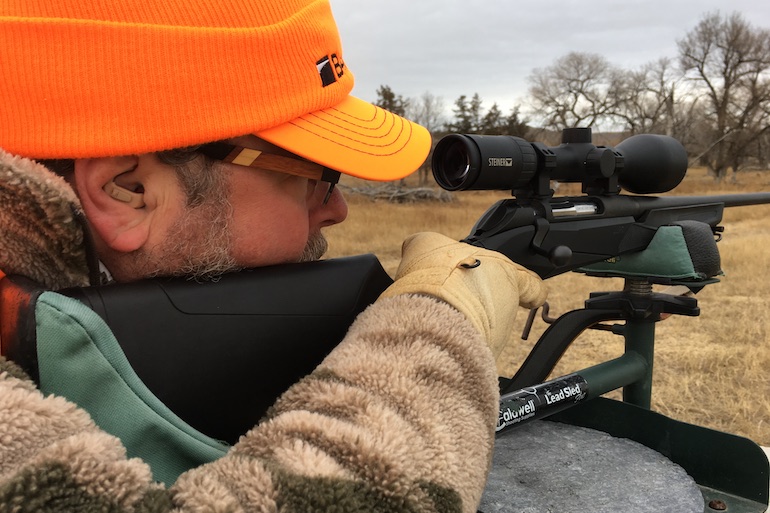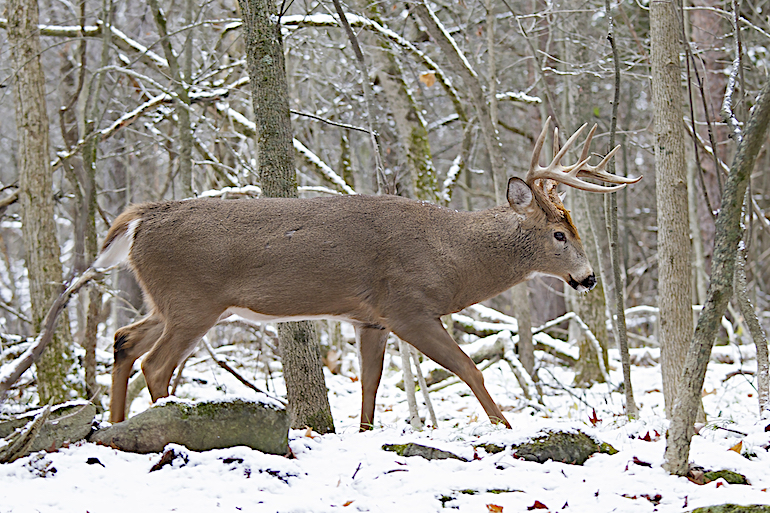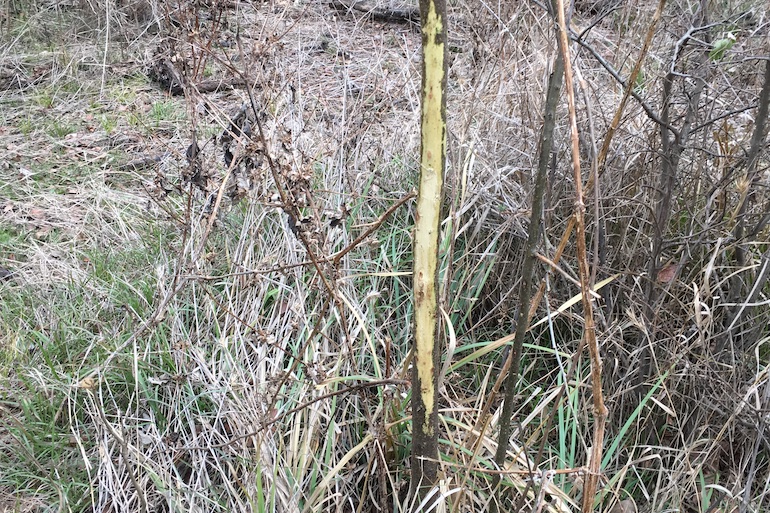
While November deer hunting gets most of the headlines, those hunters who are willing to punch the clock to the late winter buzzer can still take the trophy whitetail of a lifetime. Texas bowhunter Dale Moses did just that a few years ago, preserving through a long season of hunting that eventually culminated with a cold winter day shot that downed a big non-typical whitetail he had dubbed Captain Hook. (Photo by Lynn Burkhead)
Read deer hunting articles each fall, and you’ll see a lot of stories, a lot of photographs, and a lot of chest-thumping about the month of November. Outdoor writers are notorious for their November deer hunting praise and I’m as guilty as the rest of them.
In short, it’s the Whitetail Chamber of Commerce’s best advertising material, the month when the woods are alive with colorful leaves falling to the ground on a freshening north wind and deer-hunting prospects are at their very best.
That’s because November is when estrous does are plentiful. Mr. Big and his antlered buddies are throwing caution to the wind, and every deer trail has the potential of a whitetail love triangle straight out of the latest Yellowstone episode.
But then there’s the month of December, a time when the deer woods are suddenly as barren as Ebenezer Scrooge’s bankrupt soul, a collection of weeks as dead as the proverbial door nail pulled straight from the opening lines of Charles Dicken’s “A Christmas Carol.”
If you find yourself hunting in December with an empty buck tag in your back pocket, well, good luck. Because you’re going to need it, right?
Not necessarily. Play your cards right in the season’s 11th hour—and follow these five buzzer-beating tips—and you just might end the season smiling as big as the redeemed soul of old Ebenezer when he hears Tiny Tim cry out “God bless us everyone!”
Curious as to what you can do to tag a late-season buzzer-beater buck? Follow these five cardinal rules for late-season success.
Table of Contents
1. Hunt the Fronts
The first rule is to hunt the passage of strong cold fronts. Especially on the day or two leading up to the frontal passage as the barometer is falling, clouds are gathering, and wildlife are noticing that a storm is brewing.
Like humans do with their pre-winter storm milk and bread run rituals that wipe out the shelves at the local grocery store, wildlife do something similar as they get up, feed heavily and pile on the calories to prepare for the coming blast of Old Man Winter.
- Read more: Tag a Whitetail When It’s Hot, Cold, Wet or Windy
That’s what a bowhunting friend of mine named Tarif Alkhatib did a few years ago when he arrowed a gnarly horned, multi-tined non-typical buck in North Texas as the first Arctic blast of the season moved in.
Bundled up in his Under Armour hunting gear as the front barreled through and dropped temps into the lower 30s with light freezing precipitation, Alkhatib downed the buck as it moved quickly by his stand.

One good shot from his Mathews bow and the dedicated archer was soon on the ground shaking from both excitement and the cold as he tagged one of several wall-hangers that he’s knocked down in recent seasons.
Keep in mind that the same principle applies to a day or two after a storm, as deer get back on their feet and come out to feed and move around when the sun starts shining, the precipitation ends, and temperatures start to slowly moderate.
2. Hunt the Food
The idea noted above leads to the second rule of late-season success — hunt near high-calorie food sources. In the Midwest, that might be a cut corn field or a snow-covered soybean field. In the Deep South, it could be a green food plot or an oak tree with a few acorns still laying around. And in Texas, where I live, it could be a corn feeder shelling out golden nuggets twice a day.

Hunting late-season food is exactly what Robert Taylor did at the end of the 2012 season when he arrowed a huge North Texas non-typical whitetail that was chronicled in the pages of North American Whitetail.
The key to Taylor’s hunt — which came on the evening of Dec. 29 as cold weather and the remains of the region’s 2012 White Christmas dotted the landscape — was food.
- Read More: Field of Dreams Offer Food for Whitetails, Success for Hunters
That food was the combination of a feeder spitting corn out and a food plot that promised local deer high-caloric intake during the cold snap. That was enough to lure in several does, a good 10-point buck, and the huge bruiser that Taylor ended up shooting. All on a five-acre plot of land, no less.
Unfortunately, the Taylor buck rode a bit of a scoring roller coaster – it received a green score of 249 2/8 inches, then a 60-day entry score of 254 4/8 inches, and finally a revised Pope and Young Club panel score of 219 1/8 inches. While the middle number would have made it a Texas bow buck record, 219 and change is nothing to sneeze at and proof positive that even the buck of a lifetime can come calling if the weather is cold and there’s adequate whitetail food around.
3. Hunt Thick and Nasty Cover
On an outdoor writer’s deer hunt last December in Oklahoma with Kevin Reese and the Sight Mark optics crew, I pushed my hunting luck to the very end. But hunting a box-blind stand in a Sooner State pecan bottom during the final hour of the final day of my hunt at Dakota Stower’s most excellent North Texas Outfitters operation, I was rewarded for nothing more than sheer persistence. And sitting in a post-rut deer stand situated next to some of the area’s thickest and gnarliest cover.

As high cirrus clouds streamed in and muted the last hour’s shooting light that was filtering into the pecan bottom, a good 8-point buck stepped out of the creek bottom’s nasty vegetation where he had holed up and bedded down the entire day. But as he trotted through a brief window of a last-hour shooting opportunity before ducking back into the thick cover, one shot from my rifle put down the only deer I would tag in all of 2019.
A short while later, I was discarding the recipe for “tag soup” I had carried in my back pocket last fall, not to mention looking through my phone contact list for the number of a favored taxidermy shop, all thanks to my own buzzer-beater buck.
4. Hunt the Secondary Rut
A fourth rule in tagging a December bruiser is to remember that November doesn’t always have the market cornered on rutting activity.
That’s because of the secondary rut which occurs when does that weren’t bred in last month’s breeding frenzy actually cycle into estrous again approximately 28 days later.

While some hunters debate the strength of secondary rutting activity and its effects on big buck hunting potential, you won’t find Dallas hunter Sherman Wyman arguing about it. That’s because Wyman capitalized on the secondary rut on Dec. 24, 2005 when he shot a B&C non-typical buck netting 226 4/8 inches on his low-fence ranch near Wichita Falls in the state’s Red River country.
- Read more: Second Rut, Last Chance
“I’ve shot a lot of big deer around Christmas time,” said Wyman. “(In North Texas), everyone thinks once Thanksgiving or the first of December has come and gone, you’re done.”
Obviously not.
In Wyman’s mind, the keys to hunting the secondary rut successfully are to find scrapes that have been reopened, to identify and hunt preferred natural food sources that mature bucks tend to key on, and to be in the woods when late-born fawns come into their first estrous cycle in December.
5. Punch the Clock
A final rule to notching a tag on a December buzzer-beater buck is to employ the deer-hunting version of the photographer’s old “F8 and be there” rule.
For photographers of old-school training, that rule means to put your digital camera on manual, set the f-stop to F8 and be there for the shot.
That idea rings true for late season deer hunters too.
A deer hunting physician I once knew practiced this rule near my North Texas home many years ago just before Christmas when he carved time out of his busy holiday and professional schedule, braved some intense cold weather, and got to the nearest deer stand as the season was winding down.
Deer season, as well as the holiday season, that is.
- Read more: How to Rally for a Late-Innings Whitetail
Dr. Wade was rewarded for his consistent punching of the clock that December when he arrowed a beautiful 163 5/8 inch net typical, a wide and beautiful racked buck that adorned the good doctor’s Christmas cards that year.
My good friend Dale Moses, a passionate bowhunter and retired Texas Game Warden, has taken numerous big deer over the years with his Mathews bow, a few of those wall-hangers getting tagged in the season’s final days. That includes a late-season buzzer-beater back in 2013, one that he dubbed “Captain Hook.”
Just after Christmas that year, in a frigid stretch of weather that was gripping the North Texas woods Moses had hunted all season, his cat-and-mouse game with this big non-typical finally ended. The whopper non-typical buck placed well in the Texas Big Game Awards Program that year, scoring 184 0/8-inches.
Want to do something similar as the 2020 deer season winds down? Then get out of that easy chair, leave the warmth of the fireplace behind, and get into your deer stand, even if it’s the season’s final hours.
Because when it comes to tagging a buzzer-beater buck, you just never know, right?
“How many guys do you know that were out on a (North Texas) deer stand on Christmas Eve?” asked Sherman Wyman.
The truth is, not very many.
Only the ones whose inner hunting flame still burns hot enough to drive them out the warm comfort of home and into the chill of the late-season whitetail woods.
Which is exactly where they hope to be to beat back Jack Frost’s wintertime chill while tagging a buzzer beater buck just in time for Christmas delivery.








































